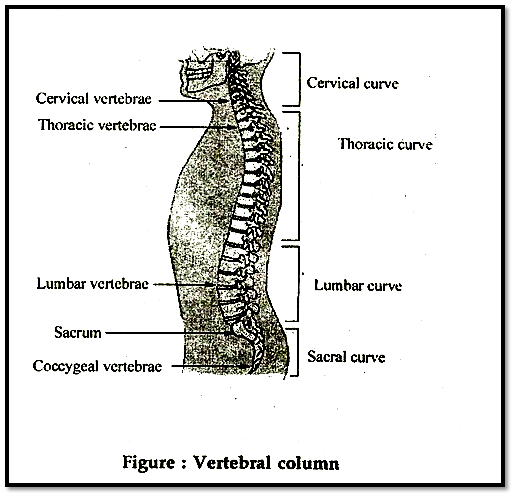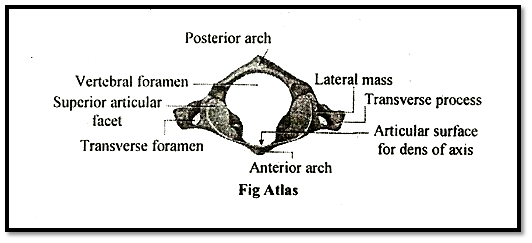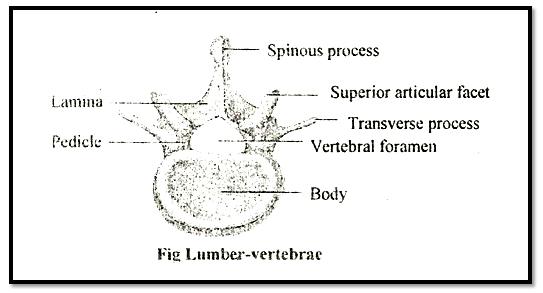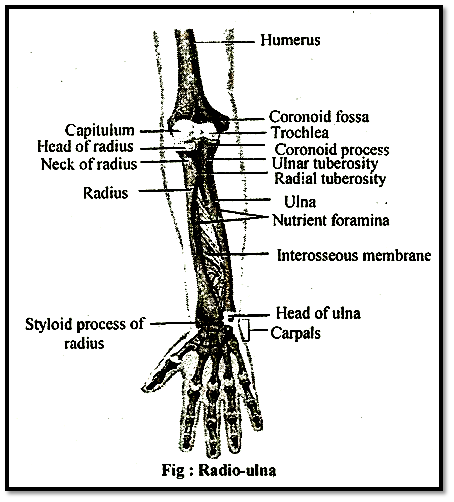Skeletal System
Table of Content |

Skeletal system consists of a framework of bone and a few cartilages.
Bone and cartilage are specialised connective tissues. The former has a very hard matrix due t calcium salts in it and the latter has slightly pliabl matrix due to chondroitin salts. In human being: this system is made up of 206 bones and a fev cartilages. It is grouped into two principal division the axial and the appendicular skeleton.

Axial skeleton comprises 80 bones distributed along the main axis of the body. The skull, vertebral colum sternum and ribs constitute axial skeleton.
The skull is composed of two sets of bones - cranial and facial, that totals to 22 bones. Cranial bones are 8 in number. They form the hard protective outer covering, cranium for the brain. The facial region is made' up of 14 skeletal elements which form the front part of the skull. A single U-shaped bone called hyoid is present at the base of the buccal cavity and it is also included in the skull.
Bones of Cranium
Frontal: Forms the forer.ead (anterior or front part of the top of cranium) and some upper parts (roofs) of eye 'orbits or sockets and nasal cavities. A newborn infant displays a faint suture in midline of frontal, indication that adult frontal is actually formed of two completely fused frontal. Frontal suture between two frontal .disappear by age 6 years. It persists throughout life it is referred as metopic sutures.
Parietals : Articulated to and situated just behind frontal. Form the main parts of bulging top and sides of cranium.
Occipital: Articulated to and situated just behind parietals, Forms posterior (back) and lower (base) parts of cranium. Foramen magnum is a large perforation in this bone. On each side of the foramen, the occipital bears a prominent elevation called occipital condyle. The condyles articulate the skull with first vertebra (atlas). Thus, human skull is dicondylic,
Temporals: Form lower parts of right and left sides of cranium, as well as, the floor of cranial cavity. These house structures of internal and middle ears and forma part of external auditory meatus. The middle ear of each side encloses the three small ear ossicles' - malleus, incus and stapes. The mastoid process with mastoid air cells in adult.
Sphenoid: A typically butterfly-shaped bone that forms the .middle and anterior parts of base of cranium in front of occipital in the middle and temporals on the sides. It articulates with all skull bones, keeping these firmly together. It also formsparts of lateral walls and floors of eye orbits.
Sphenoid with sella turcica depression for pituitary body.
Ethmoid: A small, irregular bone in front of sphenoid and behind nasal bones. It fashions the front (anterior) extremity and closer of cranial cavity. It also contributes to the architecture of eye orbits and proximal parts of nasal chambers.
Facial Bones
Nasals: Small, oblong bones in middle of upper part of face, forming proximal part of the bridge of our nose. The remaining, lower part of our nose is formed of cartilage.
Inferior nasal conchae (Turbinales): Two highly coiled, scroll-like processes of ethmoid bone, called conchae project into each nasal cavity from lateral wall of the proximal bony part of concerned nasal chamber. One ethmoidal concha is superior (uppermost). The other one is called middle concha, because it is followed by a thin, separate scrolllike bone which is named inferior nasal concha or turbinate.
Vomer: A thin, elongated, platelike bone, forming a part of the septum which separates the two nasal cavities.
Lacrimals: Small and thin, finger-shaped bones, each located in front part of the medial (inner) side of corresponding eye orbit. These form a part of the passages of corresponding tear ducts.
Zygoma tics (Malars): Cheek-bones; form the prominences of our cheeks and parts of the floor and side walls of eye orbits.
Palatines: L-shaped bones that form the back (posterior) part of our hard palate (roof of mouth). Also contribute to the framework of nasal cavities and floor of eye orbits.
Maxillae: Large, upper jaw bones that form the major part of our face and upper jaw. Comprise entire front (anterior) part of our hard palate. Also contribute to the architecture of eye orbits and nose. Bear the teeth of upper jaw.
Mandible: Largest bone of our face, and strongest of all bones of the body. Forms entire lower jaw and bears all lower jaw teeth. Articulated with temporal bones of skull. Only skull bone that moves.
The skull region articulates with the superior region of the vertebral column with the help of two occipital condyles (dicondylic skull).
Vertebral Column
It is our backbone which extends in the mid axis of the back (posterior) part of our trunk from head to the lower (inferior) extremity of trunk. Together with the sternum and rib, it forms the supporting frame work of our trunk. It support and rotate the head, suspends the viscera, protect vital organs, provides attachment to limb girdles, facilitates some movement of the trunk and houses the spinal cord. Vertebral column make two-fifth of total weight of body. The length of human vertebral column is 71 cm. (28 Inc.) in adult male and about. 61 cm (24 m) in an average adult female.
Curvatures of vertebral column: In a foetus, there is only a Single anteriorly concave curve, in adult there are 4 curves like, cervical, thoracic, lumber, and sacral. Cervical and lumber are anteriorly 'convex, while thoracic and sacral are anteriorly concave. At approximately 3rd month after birth, when an infant begins to hold its head erect, cervical curves develops, Later, when the child sits up, stands, and walks, the lumber curves further develops. The thoracic and 'sacral curves retains anterior concavity of foetus, thus are called 'Primary curves'. The cervical and lumber curves are modification of the original foetal curves, are called' "Secondary curves ".
The curves of vertebral column are important because they increases its strength, help maintain balance in upright position absorb shock during walking and running and help protect the column from fracture. Certain abnormalities of curvature are:
Kyphosis: Exaggeration of thoracic curve, resulting in "round-shouldered" appearance, also called hunch back.
Lordosis: An exaggeration of lumber curve, also called sway back.
Scoliosis: An abnormal lateral curvature in any region of spine.
The Vestigeal notochord called nucleus pulposes is found in intervertebral disc. Inter-vertebral disc is fibro cartilagenous disc present between centrum of vertebrate.
Our vertebral column is formed by 26 'serially arranged units called vertebrae and is dorsally placed. It extends from the base of the skull and constitutes the main framework of the trunk. Each vertebra has a central hollow portion (neural canal) through which the spinal cord passes. First vertebra is the atlas and it articulates with the occipital condyles. The vertebral column is differentiated into cervical (7), thoracic (12), lumbar (5); sacral (1- fused) and coccygeal (1-fused) regions starting from the skull. The number of cervical vertebrae are seven in almost all mammals including human beings.
Atlas Vertebra
(i) First cervical vertebra.
(ii) Body is formed of vertebral arch transverse process:
(iii) It supports the globe of the head like the earth by the atlas (super man).
(iv) Centrum is absent.
(v) Neural spine absent.
(vi) Transverse process are long with transverse foramen.
Thoracic Vertebra
(i) Centrum acoelus.
(ii) Neural canal is formed by union of two neural arches.
(iii) Neural spine is a flat & long directed backward.
(iv) Club shaped transverse process.
(v) Neural arch with superior articular process.'
(vi) Two demifacets for articulation of head of a rib are present.
Lumber Vertebra
(i) Centrum acoelus.
(ii) Neural spine well developed.
(iii) Transverse process are thin and long.
(iv) Small accessory process present near the root of each transverse process.
(v) It is the largest vertebrae.
Sacrum: It is a triangular bone formed by fusion of 5 sacral vertebra.
(i) Fusion normally begins between 16 to 18 years of age and is completed by 30 yrs. of age.
(ii) Serves as strong foundation for pelvic girdle.
(iii) Sacrum with 4 pairs of anterior and posterior sacral "foramina.
(iv) Lateral part of sacrum articulate with ilium of hip bone.
(v) Female sacrum is shorter, wider and more curved between 52 and 53 the male sacrum is longer, narrower, and less curved.
(vi) In birds some of the vertebrae are fuse to form synsacrum. [Last thoracic+ Lumber+ Sacral+ One or two caudal]
Coccyx
(i) It is formed by fusion of four coccygeal vertebrae.
(ii) It is last section of backbone.
(iii) It is small triangular bone.
(iv) Two coccygeal cornua project up to articulate with sacral cornua.
(v) Rudimentary transverse process.
(vi) Fusion generally occurs between 20 and 30 years of age.
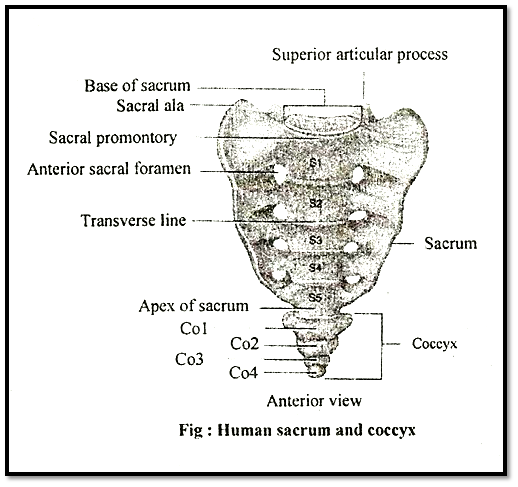
The vertebral column protects the spinal cord, supports the head and serves as the point of attachment for the ribs and musculature of the back.
The ribs' are curved bars, which movably articulate with the thoracic vertebrae at the back and while with the sternum in front. All collectively forming a bony cage, the thoracic basket.
There are 12 pairs of ribs. Each rib is a thin flat bone connected dorsally to the vertebral column and ventrally to the sternum. It has two articulation surfaces on its dorsal end and is hence called bicephalic. First seven pairs of ribs are called true ribs. Dorsally, they are attached to the thoracic vertebrae and ventrally connected to the sternum with the help of hyaline cartilage. The 8th, 9th and 10th- pairs of ribs do not articulate directly with the sternum but join the seventh rib with the help of hyaline cartilage. These are called vertebrochondral (false) ribs. Last 2 pairs (11th and 12th) of ribs are not connected ventrally and are therefore, called floating ribs. Thoracic vertebrae, ribs and sternum together form the rib cage.
The ribs serve three important functions
a) They protect the heart, large blood vessels and lungs.
b) They bear respiratory muscle (external and internal intercostal muscle).
c) Lower two pair of ribs protect the kidney. (11th and 12th)
Sternum
-
It is bone of chest.
-
It is absent in fish turtle.
-
It is associated with pectoral girdle in amphibia.
-
In man it is made up of cervical manubrium (presternum), mesosternum and xiphoid process (Metasternum).
-
(v ) In male it is nearly 17 cm long.
-
Manubrium is broad and thick.
-
Mesosternum is made up fine sternabae.
-
Metasternum is represent by xiphisternum which is smallest broad and thin. In mammal a cartilagenous plate attached with xiphisternum is known as xiphoid cartilage (hyaline).
-
Sternum = Manubrium + 5 sternabrae + Xiphisternum.
-
The sternum has two function:
-
It takes part in the formation of the 'protective thoracic basket.
-
It plays a role in the respiratory mechanism.
-
The bones of the limbs alongwith their girdles constitute the appendicular skeleton. Each limb is made of 30 bones. The bones of the hand (fore limb) are humerus, radius and ulna, carpals (wrist bones - 8 in number), metacarpals (palm bones - 5 in number) and phalanges (digits -14 in number). Femur (thigh bone - the longest bone), tibia and fibula, tarsals (ankle bones - 7 in number), metatarsals (5 in number) and phalanges (digits - 14 in number) are the bones of the legs (hind limb). A cup shaped bone called patella covers the knee ventrally (knee cap).
Pectoral and pelvic girdle bones help in the articulation of the upper and the lower limbs respectively with the axial skeleton. Each girdle is formed of two halves. Each half of pectoral girdle consists of a clavicle and a scapula. Scapula is a large triangular flat bone situated in the dorsal part of the thorax between the second and the seventh ribs.
The dorsal, flat, triangular body of scapula has a slightly elevated ridge called the spine which projects as a flat, expanded process called the acromion. The clavicle articulates with this. Below the acromion is a depression called the glenoid cavity which articulates with the head of the humerus to form the shoulder joint. Each clavicle is a long slender bone with two curvatures. This bone is commonly called the collar bone.
Pelvic girdle consists of two coxal bones. Each coxal bone is formed by the fusion of three bones - ilium, ischium and pubis. At the point of fusion of the above bones is a cavity called acetabulum to which the thigh bone articulates. The two halves of the pelvic girdle meet ventrally to form the pubic symphysis containing fibrous cartilage.
Limb bones: Limb are of two types fore limb and hind 'limb,
Bones of Fore Limbs
a) Humerus or arm bone or bone of upper arm, is longest and largest bone of upper limb.
b) It articulates proximally with scapula and distally at the elbow with both ulna and radius.
c) Humerus proximal" end with greater and lesser tuberosity tubercle.
d) Both radius and' ulna are with nutrient foramina.
e) Radius present towards thumb side.
f) Ulna present towards little finger side.
g) It includes humerus + radius & ulna + carpals + meta . carpals + Phalanges.
h) Humerus is characterised by presence of deltoid tuberocity for the attachment of muscles.
i) Distal end of humerus at the elbow joint is like pully and called trochlea. Its groove is called olecranon fossa whose basal part is marked by a supratrochlear foramen for the passage of brachial artery and nerve.
j) Humerus is characterised by arterial foramen.
k) Head of the humerus articulate with glenoid cavity of pectoral girdle.
l) Radius is smaller and ulna is larger, were bones of fore arm.
m) Styloid process is present in distal end of ulna and radius both.
n) Olecranon process is present in ulna. Proximally, which forms prominence of elbow.
o) Trochlear notch is formed by ulna which is also known as sigmoid notch.
p) Carpals or wrist bone are eight in number, joined to one another by ligaments. Carpals are arranged in 2 rows, with 4 bones in each row.
q) Metacarpals are five in number, and phalanges are - fourteen, phalanges formula = 2, 3, 3, 3, 3.
Bones of Hind Limbs
a) It includes Femur + Tibia and Fibula + Tarsals + Metatarsals + Phalanges
b) Fovea capitis is depression in head of femur.
c) Femur is longest and strongest bone of body.
d) Femur is known as bone of thigh
e) Greater trochenter, lesser trochenter 3rd trochonter are present in femur, of thigh and buttock muscles.
f) Patellar groove in found in distal end of femur.
g) Fibula is smaller and associated with knee joint.
h) Tibia is larger, also called shin bone. It bears a weight of body.
i) Tarsal bones are seven.
j) Metatarsals are five.
k) Phalanges are fourteen.
l) Phalanges formula = 2, 3, 3, 3, 3
m) Patella form knee cap.
n) Patella is formed by sesamoid bone. Fabella is also example of sesamoid bone.
o) Thumb of foot is called hallux.
p) Ankle bones have 7 tarsals and arranged in two rows then 1st row have talus and calcaneus, second row with cuboid, Navicular, and I, II, III cuneiform.
Joints
Joints are points of contact between bones, or between bones and cartilages. Force generated by the muscles is used to carry out movement through joints where the joint acts as a fulcrum. The
movability at these joints vary depending on different factors. Joints have been classified into three major structural forms, namely, fibrous, cartilaginous and synovial.
Fibrous joints do not allow any movement. This type of joint is shown by the flat skull bones which fuse end-to-end with the help of dense fibrous connective tissues in the form of sutures, to form the cranium.
In cartilaginous joints, the bones involved are joined together with the help of cartilages. The joint between the adjacent vertebrae in the vertebral column is of this pattern and it permits limited movements.
Synovial joints are characterised by the presence of a fluid filled synovial cavity between the articulating surfaces of the two bones. Such an arrangement allows considerable movement. These joints help in locomotion and many other movements. Ball and socket joint (between humerus and pectoral girdle), Hinge joint (knee joint), Pivot joint (between atlas and axis), Gliding joint (between the carpals) and Saddle joint (between carpal and metacarpal of thumb) are some examples.
Disorders of Muscular and Skeletal System
Myasthenia gravis: Auto immune disorder affecting neuromuscular junction leading to fatigue, weakening and paralysis of skeletal muscle.
Muscular dystrophy: Progressive degeneration of skeletal muscle mostly due to genetic disorder.
Tetany: Rapid spasms (wild contractions) in muscle due to-low Ca++ in body fluid.
Arthritis: Inflammation of joints.
Osteoporosis: Age-related disorder characterised by decreased bone mass and increased chances of fractures. Decreased levels of estrogen is a common cause.
Gout: Inflammation of joints due to accumulation of uric acid crystals.
Sprain: Sprain refers to injury to a joint capsule, typically involving a stretching or tearing of tendons or ligaments. Unfortunately, both these structures have much poorer regenerative power than bone, and once stretched often remain weak. Sprain is often considered a minor disorder, but it may become chronic.
Fracture: Fracture is a break of a bone. Fracture occurs rarely in children. The bones of children have a large quantity of organic matter and are, therefore, very flexible and less likely to break. With advancing age, mineral matter (calcium phosphate) is deposited in the bones. This decreases the organic matter, making the bones hard and brittle. Thus, old people are more liable to fracture of bones. Bones fractures are of many types.
(a) Green-stick fracture or complete: It is mearly a crack. The bones remains partly intact, occurs only in children.
(b) Simple or complete fracture: Bone breaks completely into two parts which remain close to each other.
(c) Comminuted fracture: Bone breaks into more than two pieces (smaller fragments between two main fragment)
(d) Compound fracture: Bone breaks completely but a fragment pierces out through the skin.
(e) Evulsive fracture: A small piece breaks off fully from the bone but remains attached to the ligament. Fractures need surgical treatment for healing and should be promptly and properly attended to.
Note:
Bones of upper limb (Fore limbs) of Man
(a) Arm - Brachium - Humerus = 1 bone
(b) Fore arm - Antibrachium - Radius + Ulna =-2 bone
(c) Wrist-Carpus = 4 + 4 carpals = 8 bone
(d) Palm - Metacarpals - 5 metacarpals = 5 bone
(e) Fingers - Phalangeal formula - 2 3 3 3 3 = 14 bone
Total = 30 bone
In upper arm total 30 bones are present.
Bones of lower limb - Hind limbs of man
Thigh – Femur : 1 bone
Knee - Knee cap - patella : 1 bone
Leg - Tibia + Fibula:2 bone
Ankle - 7 tarsals :7 bone
Sole - 5 Meta tarsals :5 bone
Phalangeal formula - 2 3 3 3 3:14 bone
Total: 30 bone
In man total no. of muscles: 656 muscles
|
Bleeps and Triceps |
Arm |
|
Gastrocnemius |
Shank of leg |
|
Gluteimaximus |
Buttock muscles |
|
Oblique |
Eye muscles |
|
Rectus |
Eye muscles |
|
Maxillaries |
Upper jaw |
|
Pectoralis Major |
Chest |
|
Pectoralis Minor |
Chest |
|
Mandibularis |
Muscle of lower jaw |
|
Latissisus dorsi |
Shoulder muscle |
|
External oblique |
Lower abdomen |
|
internal oblique |
Lower abdomen |
|
Transversus |
Lower abdomen |
|
Rectus abdominus |
Lower abdomen |
|
Stepedial muscle / arrector pilli |
Smallest muscle |
|
Sartorius femoris |
Longest muscle |
|
Gluteus maximus |
Largest muscle |
Bone of lower jaw - Mandible.
Strongest - bone of axial skeleton = Mandible (Lower jaw)
Neurocranium - A part of skull having brain and sensory capsules.
Sella turcica - Depression in sphenoid of skull that lodges pituitary body.
Wish bone - It is V-shaped bone formed by the fusion of clavicle and inter clavicle in bird. It is also named as Merry thought bone.)
Largest foramen - Foramen of magnum at the base of cranium from where brain enters into spinal cord.
Weberian Ossicles - Small bones developed from 1st four vertebrae of bony fishes like carp and cat fish. These connect air bladder to internal ear and act as a barometer)
Smallest bone - Stapes
Longest bone - Femur
Movable joints are called synovial joints.
Synovial joints have a synovial or joint cavity, a space between articulating bones.
Articular cartilage covers the surface of articulating bones.
Articular cartilage of synovial joints is hyaline cartilage.
Synovial joints are surrounded by a tubular articular capsule.
The articular capsule consists of two layers; outer fibrous capsule and inner synovial membrane.
The synovial membrane secretes synovial fluid which lubricates and provides nourishment to articular cartilage.
In old age, stiffness of joints is due to the decrease in synovial fluid.
Structural arrangement of a perfect joint permits considerable movement of articulating bones without danger of friction.
Due to the elasticity of the ligaments of the wall of joint capsule, articulating bones automatically return back to their normal positions after movements.
Sprain is caused by excessive stretching of ligament at the joint. It causes pain and swelling,
Dislocation between two bones may occur when ligament ruptures or it is torned and the bones are displaced.
In human vertebrae are grouped into five groups namely cervical, thoracic, lumber, sacrum, coccygeal
|
Category |
Name of vertebrae |
Number |
Region Neck |
Curve |
|
1. |
Cervical |
7 (1st atlas) (2nd Axis) |
chest |
Cervical curves forward |
|
2. |
Thoracic |
12 |
Abdomen |
Thoracic curves backward |
|
3. |
Lumbar |
5 |
Pelvis |
Lumbar curves forward |
|
4. |
Sacral |
5 (fused to form a single sacrum) |
Vestigeal tail |
Sacral curves backward |
|
5. |
Coccygeal |
4 (fused to form a single coccyx) |
Region Neck |
Coccyx curves forward |
To read more, Buy study materials of Locomotion and Movement comprising study notes, revision notes, video lectures, previous year solved questions etc. Also browse for more study materials on Biology here.
View courses by askIITians


Design classes One-on-One in your own way with Top IITians/Medical Professionals
Click Here Know More

Complete Self Study Package designed by Industry Leading Experts
Click Here Know More

Live 1-1 coding classes to unleash the Creator in your Child
Click Here Know More

a Complete All-in-One Study package Fully Loaded inside a Tablet!
Click Here Know MoreAsk a Doubt
Get your questions answered by the expert for free


